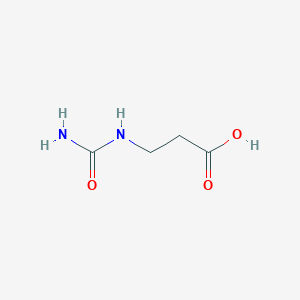| General Information of MET (ID: META00128) |
| Name |
Ureidopropionic acid
|
| Synonyms |
Click to Show/Hide Synonyms of This Metabolite
3-(carbamoylamino)Propanoate; 3-(carbamoylamino)Propanoic acid; 3-Ureidopropanoate; 3-Ureidopropanoic acid; 3-Ureidopropionate; 3-Ureidopropionic acid; 3-[(Aminocarbonyl)amino]propanoate; 3-[(Aminocarbonyl)amino]propanoic acid; 3-ureido-Propionate; Carbamoyl-b-ala-OH; Carbamoyl-beta-ala-OH', N-(Aminocarbonyl)-'b-alanine, 'N-Carbamyl-b-alanine; Ion(-1) OF N-carbamoyl-beta-alanine; N-(AMINOCARBONYL)-BETA-alanine; N-Carbamoyl-beta-alanine; N-Carbamyl-beta-alanine; Ureidopropanoate; Ureidopropanoic acid; Ureidopropionate; b-Ureidopropionate; b-Ureidopropionic acid; beta-Ureidopropionic acid
|
| Source |
Endogenous;Escherichia Coli Metabolite;Food;Microbial
|
| Structure Type |
Ureas (Click to Show/Hide the Complete Structure Type Hierarchy)
Organic acids and derivatives
Organic carbonic acids and derivatives
Ureas
|
| PubChem CID |
|
| HMDB ID |
|
| Formula |
C4H8N2O3
|
| Structure |
<iframe style="width: 300px; height: 300px;" frameborder="0" src="https://embed.molview.org/v1/?mode=balls&cid=111"></iframe>
|
 |
|
3D MOL
|
2D MOL
|
|
Click to Show/Hide the Molecular/Functional Data (External Links/Property/Function) of This Metabolite
|
| KEGG ID |
|
| ChEBI ID |
|
| FooDB ID |
|
| ChemSpider ID |
|
| Physicochemical Properties |
Molecular Weight |
132.12 |
Topological Polar Surface Area |
92.4 |
| XlogP |
-1.5 |
Complexity |
123 |
| Heavy Atom Count |
9 |
Rotatable Bond Count |
3 |
| Hydrogen Bond Donor Count |
3 |
Hydrogen Bond Acceptor Count |
3 |
| Function |
Ureidopropionic acid, also known as 3-ureidopropanoate or N-carbamoyl-beta-alanine, belongs to the class of organic compounds known as ureas. Ureas are compounds containing two amine groups joined by a carbonyl (C=O) functional group. Ureidopropionic acid is an intermediate in the metabolism of uracil. More specifically, it is a breakdown product of dihydrouracil and is produced by the enzyme dihydropyrimidase. It is further decomposed into beta-alanine via the enzyme beta-ureidopropionase. Ureidopropionic acid is essentially a urea derivative of beta-alanine. High levels of ureidopropionic acid are found in individuals with beta-ureidopropionase (UP) deficiency. Enzyme deficiencies in pyrimidine metabolism are associated with a risk for severe toxicity against the antineoplastic agent 5-fluorouracil. Ureidopropionic acid has been detected, but not quantified in, several different foods, such as gram beans, broccoli, climbing beans, oriental wheat, and mandarin orange (clementine, tangerine). This could make ureidopropionic acid a potential biomarker for the consumption of these foods.
|
|
Regulatory Network
|
|
|
|
|
|
|
|
|
 click to show the details of this protein
click to show the details of this protein
 click to show the details of experiment for validating this pair
click to show the details of experiment for validating this pair

